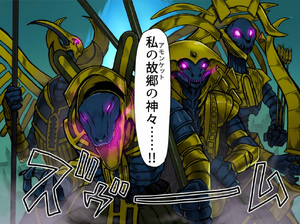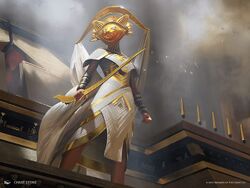Oketra
| Oketra | |
|---|---|
| God of Solidarity | |
| Information | |
| Colors |
|
| Species | God Eternal |
| Birth, Life & Death | |
| Birthplace | Amonkhet |
| Death |
4560 AR Eternalized 4560 AR Killed 4560 AR |
| Family | |
| Children | Ketramose |
Oketra was the revered cat-headed deity of Amonkhet, embodying the ideals of stability, order, and protection among her people. As the goddess of solidarity, she watched over the crops of initiates who trained under her vigilant gaze, teaching them to stand strong as one. Oketra's presence in Naktamun was a symbol of hope and unity, and her golden arrows were both a literal and spiritual safeguard against the chaos of the encroaching desert and the monsters that lurked beyond the Hekma. Her influence shaped the city's culture, reminding every citizen that true strength came from working together in perfect harmony.
Description
Oketra valued coordinated purpose and cooperative action. Her Trial of Solidarity was the first one undergone by initiates, forcing them to rely on the other members of their crops and stand or fall together.[1] She was an archer with unshakable focus who never missed her mark. Her arrows were made from the light of the Second Sun, and a single wound was enough to take down even the largest desert horror.[2] Oketra's viziers oversaw the city of Naktamun and were responsible for raising and educating its people.[3]
History
Amonkhet
On Amonkhet, Oketra was the goddess of solidarity. She patrolled the city's streets, firing golden arrows at any dangers she saw through the Hekma, and inscribing glowing glyphs into the various crops' obelisks to honor them.[4] She led many initiates through the first Trial: "At the beginning of the trial, Oketra shoots a massive arrow to the far side of the chamber. The floor of her monument shifts, creating a treacherous landscape, and all manner of enemies swarm in—viziers, anointed mummies, horned beasts, and even angels. The enemies assault both the initiates and their obelisk. The crop must work together to defend their obelisk and retrieve Oketra’s arrow. They succeed or fail together."
Hour of Devastation
In the Hour of Promise, Oketra was killed by the Scorpion God.[5] One of her last acts was to heal some of the people of Naktamun who were caught in the Hour of Devastation, staying true to her nature to protect the innocents she had sworn to watch over. Even in death, her example inspired the remaining survivors to stand together against the horrors unleashed by Nicol Bolas.
War of the Spark

Oketra was zombified. During the War of the Spark on Ravnica, she reappeared as a God-Eternal in Bolas's army. While under Liliana's command, she took a shot at Gideon with her bow, as he charged at Bolas to deliver the killing blow. However, Liliana interfered, causing the Divine Arrow to miss and impale Gideon's Pegasus instead, leaving Gideon tumbling through the air. After she repented, Liliana commanded Oketra and Bontu to attack Bolas.[6] As Oketra and Bontu advanced, Nicol Bolas remained confident and defiant but was surprised by Niv-Mizzet who impaled the God-Pharaoh through the back with Hazoret's spear. Bolas managed to obliterate Oketra, but the distraction gave Bontu the opening to bite Bolas and despark him.[7]
After her final defeat, fragments of her lazotep-covered remains are kept in the Museum of Ravnica.
Legacy
After the New Phyrexian Invasion and the long-awaited restoration of Naktamun and the Luxa, a new leonine god named Ketramose was born to embody hope for the future.[8] Ketramose considers Oketra his mother and spiritual predecessor, carrying her mighty bow and defending her faithful as a living testament to her legacy.[9] Through him, Oketra’s ideals of solidarity and protection continue to guide the people of Amonkhet.
Inspiration
Oketra could be inspired by Bastet, the Egyptian goddess of dance, music, protection, and family. She could also be inspired by Sekhmet, the lion-headed goddess of war and healing. Bastet was also a lion-faced war deity, but her image changed over time to a more protective cat goddess. Sekhmet had close ties to the sun, and so did Bastet before becoming associated with the moon after Greek influence. Another inspiration would be Nebet-Het, a goddess who represents divine assistance and protective tutelage.
Gallery
-
God-Eternal Oketra
Story appearances
In-game references
- Represented in:
- Associated cards:
- Depicted in:
- Austere Command (Amonkhet Invocations)
- Cartouche of Solidarity
- Despark
- Liliana's Triumph
- Pyramid of the Pantheon
- Renewed Faith
- Solemnity
- Storm the Citadel
- Trial of Solidarity
- Vindicate (Amonkhet Invocations)
- War of the Spark
- Worship (Amonkhet Invocations)
- Worship (Signature Spellbook: Gideon)
- Zombie Warrior (Token)
- Quoted or referred to:
References
- ↑ Wizards of the Coast. Explore the planes: Amonkhet
- ↑ Ethan Fleischer (2017). Amonkhet Player's Guide. Wizards of the Coast.
- ↑ Jay Annelli (2022). Magic: The Gathering - The Visual Guide, DK. ISBN-13 978-0744061055.
- ↑ James Wyatt (July 2017) - The Art of Magic: The Gathering - Amonkhet, Viz Media.
- ↑ Alison Luhrs (June 28, 2017). "The Hour of Promise". magicthegathering.com. Wizards of the Coast.
- ↑ Greg Weisman (April 2019). "War of the Spark: Ravnica". Del Rey.
- ↑ Greg Weisman (June 12, 2019). "War of the Spark: Ravnica – Ashes". magicthegathering.com. Wizards of the Coast.
- ↑ Miguel Lopez (December 11, 2024). "Planeswalker's Guide to Aetherdrift, Part 2". magicthegathering.com. Wizards of the Coast.
- ↑ Hadeer Elsbai (January 13, 2025). "Hour of Restoration". magicthegathering.com. Wizards of the Coast.

